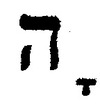Chapter 4 - Hebrew Nouns Flashcards
(31 cards)
What are the masculine singular noun endings?
No set pattern (endingless).
What is the masculine plural noun ending?

What is the masculine dual noun ending?

What are the feminine plural noun endings?

What is the feminine plural noun ending?

What are the feminine plural dual endings?

Identify:

Feminine singular noun
Identify:

Feminine singular noun
Identify:

Feminine singular noun
Identify:

Feminine singular noun
Identify:

Feminine singular noun
Identify

Masculine plural noun
Identify:

Feminine plural noun
Identify:

Masculine dual noun
Identify:

Feminine dual noun
Identify:

Feminine dual noun
עִיר (city) and אֶבֶן (stone) are exeptions to the normal noun ending patterns because…
they are endingless feminine singular.
אָב Is an exception to the normal noun pluralisation pattern because…
though it is masculine singular, it takes the feminine plural ending
מַיִם (water) is an exception to the normal noun pluralisation pattern because…
it is always dual in form, but should usually be translated in the singular.
אִישׁ (man) does not follow the normal pattern of noun pluralisation because…
the stem of the word undergoes an irregular change. In this instance אִישׁ becomes אֲנָשִׁים
The 5 types of noun pluralisation are:
- Regular
- Propretonic
- Segholate
- Geminate
- Irregular
What is the tonic syllable?
The syllable that is accented within a word. Unless otherwise indicated, it is the last syllable.
What is the pretonic syllable?
The syllable before the tonic.
What is the propretonic syllable?
The syllable before the pretonic syllable.


